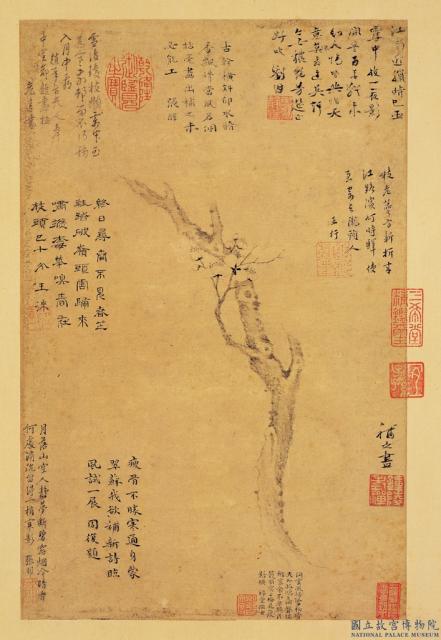集古圖繪 冊 宋揚无咎梅花
推薦分享
資源連結
連結到原始資料 (您即將開啟新視窗離開本站)後設資料
- 資料識別:
- 故畫001258N000000001
- 資料類型:
- 類型:繪畫
- 型式:靜態圖像
- 著作者:
- 揚无咎
- 主題與關鍵字:
- 梅(白.紅.蠟梅)
- 出版者:
- 數位化執行單位:國立故宮博物院
- 格式:
- 本幅 41.2x26.6公分、全幅 50.2x77.3公分
- 關聯:
- 石渠寶笈初編(重華宮),上冊,頁727&*故宮書畫錄(卷六),第四冊,頁250&*1.劉芳如,〈宋揚无咎梅花〉,收入國立故宮博物院編輯委員會編,《畫梅名品特展》(臺北:國立故宮博物院,1991年元月初版),頁79-80。 2.〈宋 揚无咎 梅花〉,收入譚怡令、劉芳如、林莉娜主編,《滿庭芳 歷代花卉名品特展》(臺北:國立故宮博物院,2010年十二月初版一刷),頁130。 &* 揚无咎(1097-1169),先祖為四川成都人,到他才遷居臨江(今江西南昌)。自號逃禪老人、清夷長者。為人高標自適,兼擅詩詞書畫。畫梅花的圈瓣法,從北宋華光和尚蛻變而來,又加上書法學瘦勁的歐陽詢(557-641)體,因而自有新意。 本幅選自<集古圖繪冊>,於畫幅中央水墨畫梅幹一枝,雖幅中題跋幾佈滿畫面,但並無損於畫家以簡潔的筆意,展現梅的隽拔幽雅和文人雅趣,也適度地表達了畫家孤芳自賞的個性。(20110102)&* Yang Wujiu’s ancestors came from Chengdu in Sichuan, but his family moved to Linjiang (modern Nanchang, Jiangxi). Yang went by the self-styled sobriquets Taochan laoren and Qingyi zhangzhe. He was lofty and restrained in his conduct, also excelling at poetry, calligraphy, and painting. In the depiction of plum blossoms, he used the “circled-petal” method, which derived from the style of the Northern Song monk-artist Huaguang. And by adding the thin yet powerful style of Ouyang Xun (557-641) to his calligraphy, Yang was able to develop a manner of his own. This leaf comes from the album “Paintings of Collected Antiquity.” It depicts the trunk of a plum tree in the center of the composition using monochrome ink. Although inscriptions cover nearly the entire surface, they do not take away from the artist’s simple yet clear brush manner. This work reveals the leisurely and serene elegance of the plum tree and literati interests, also suitably expressing the artist’s character of “a solitary flower enjoying its own fragrance.”(20110102)
- 管理權:
- 國立故宮博物院
授權聯絡窗口
- 國立故宮博物院圖像授權、出版授權、影音資料授權-申請流程說明
http://www.npm.gov.tw/zh-TW/Article.aspx?sNo=03003061






